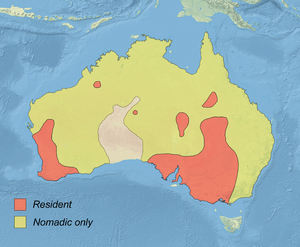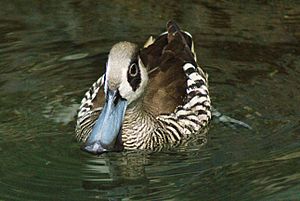Pink-eared duck facts for kids
Quick facts for kids Pink-eared duck |
|
|---|---|
 |
|
| Conservation status | |
| Scientific classification | |
| Genus: |
Malacorhynchus
|
| Species: |
membranaceus
|
 |
|
| Distribution map of the pink-eared duck | |
The pink-eared duck (Malacorhynchus membranaceus) is a unique type of duck. You can find this special bird living in Australia. It has a large, spoon-shaped bill, similar to the Australasian shoveler. However, the pink-eared duck is smaller, usually about 38 to 40 centimeters long.
This duck is easy to spot! It has a brown back and head, with black and white stripes on its sides. It also has black patches around its eyes on an otherwise white face. Young ducks look similar but are a bit duller in color. The name "pink-eared" comes from a small pink spot near its eye. This spot is hard to see unless you are very close. Because of its stripes, some people also call it the zebra duck.
Contents
About the Pink-Eared Duck
The pink-eared duck was first described in 1801 by an English bird expert, John Latham. He gave it the scientific name Anas membranacea. Today, it is the only living member of its group, called Malacorhynchus.
Scientists believe this duck might be related to shelducks. It could also be connected to the musk duck and the stiff-tails. What makes this duck even more special is its pink "ear" spot. This spot gets its color from special pigments called carotenoids. The pink-eared duck is the only bird in its group known to have these pigments in its feathers.
Where Pink-Eared Ducks Live
Pink-eared ducks live all over Australia. They can move around a lot, appearing wherever there is standing water. This is especially true in dry inland areas. In these places, there is usually not much rain. But when water appears, the ducks quickly find it.
What Pink-Eared Ducks Eat

These ducks mainly eat tiny living things found in water, like plankton. They also enjoy small crustaceans, mollusks, and insects. Their unique bill is perfect for filtering these tiny organisms. It has flexible flaps that help channel water. This allows the ducks to easily strain out algae and other plankton.
Sometimes, two ducks will even work together to find food. They spin around a central point, with one duck's head facing the other's tail. This spinning motion creates a swirling column of water. This helps to gather food in one spot, making it easier to catch.
Pink-Eared Duck Reproduction
Pink-eared ducks start nesting when pools of water begin to dry up and then refill. This process helps create more organic material in the water, which is important for their food. In good years, many pink-eared ducks will gather in shallow floodplains to breed. However, if the conditions are not right, they might not reproduce at all that year.
See also
 In Spanish: Pato pachón para niños
In Spanish: Pato pachón para niños


